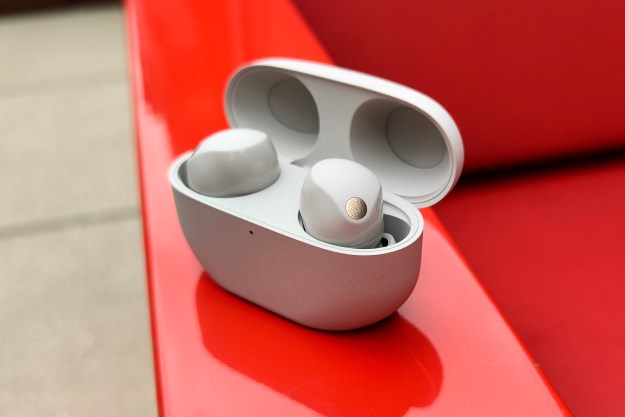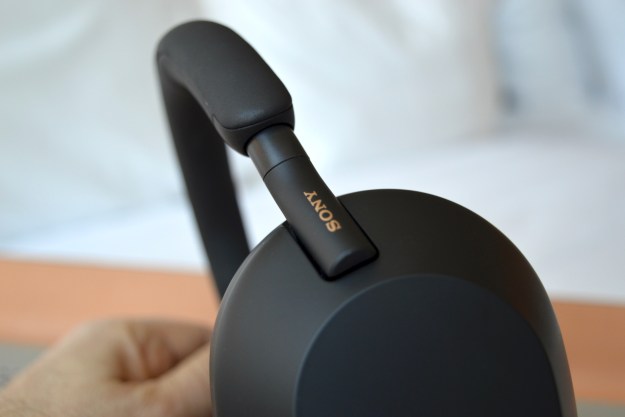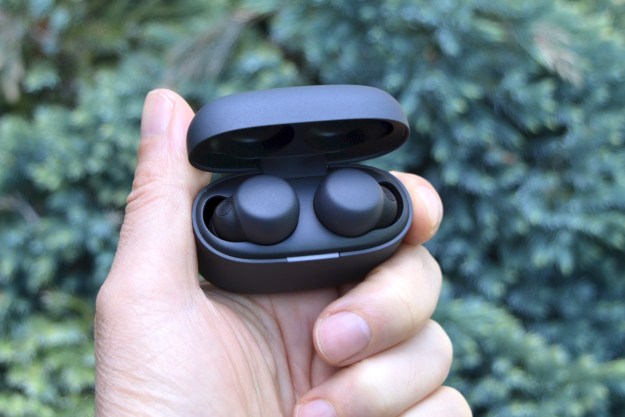
“Excellent ANC and unique features make these earbuds an intriguing new option.”
- Small and light
- Very good sound quality
- Excellent noise canceling
- Handy transparency features
- Wear sensors
- IPX4 water resistance
- Mediocre battery life
- Quirky control options
- No wireless charging
- No Bluetooth Multipoint
Sony’s $180 LinkBuds amazed and perplexed me. Their original premise — that it should be possible to enjoy high-quality sound while also maintaining a barrier-free connection to the outside world — was intriguing. Same for their donut-shaped speakers. And despite a few drawbacks, they largely worked.
But the LinkBuds certainly aren’t for everyone. Now, Sony has introduced the $200 LinkBuds S, with a totally different wireless earbud design from the LinkBuds. The company says its target audience is the same as the original LinkBuds — those who like to spend their days connected to their digital and real worlds, moving seamlessly between them. “Always on, never off,” is the LinkBuds’ family catchphrase.
Without the open design of the first LinkBuds, it’s hard to see how that works. But with a light and small shape, features like speak-to-chat, the as-yet-unreleased “Auto Play,” and wireless hi-res audio, Sony definitely feels the LinkBuds S offer something new, that no other earbuds can match at any price. But is it something that you’ll want? Let’s take a look.
About that box

Inside the box, you’ll find the LinkBuds S already in their charging case, four sets of silicone eartips in total (mediums are installed by default), and a very short, 7.8-inch USB-A-to-USB-C charging cable. But it’s the box itself that deserves special praise: It’s made of partially recycled (and fully recyclable) cardboard and paper, without a hint of plastic anywhere.
It’s easily the most eco-friendly packaging in the industry, and we hope the other players take note — I’m sure this is one innovation Sony won’t mind if its competitors imitate.
Design

Taking cues from its siblings, the $99 Sony WF-C500 and $280 WF-1000XM4, the LinkBuds S are smaller than both of those models, with an understated, matte-textured finish in black (technically a two-tone black/gray), white, or a Best Buy-exclusive sandy color called ecru. That texture, which adorns the charging case too, makes the buds easy to grip, but it isn’t so rough that it’s uncomfortable.
They’re so small, they’re one of the few models of wireless earbuds that I can wear under a motorcycle helmet because they barely protrude from my ears. Like the XM4, the entire outer surfaces act as touch controls, while a small, circular windscreen conceals the LinkBuds S mics.
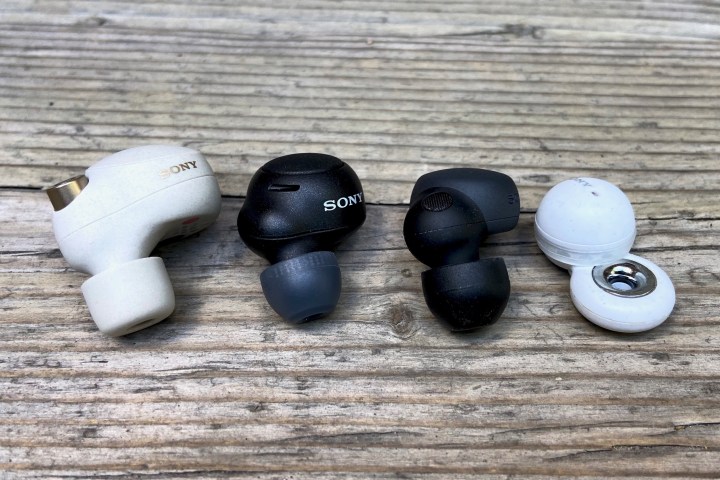
The charging case also is very compact, and while I didn’t intentionally try to damage it, I suspect that the textured finish will hold up well in the inevitable collision with keys and other objects in your pocket or purse. The lid and hinge work smoothly, with none of the floppiness that cheaper units sometimes suffer from, and the magnetic closure has just the right amount of pull.
These are easily the most comfortable Sony buds I’ve worn so far.
A slender LED strip along the front lets you know its charging state. The only thing missing here is wireless charging — a surprise given that most charging cases at this price now have this feature.
As with all of Sony’s current generation of wireless earbuds, the LinkBuds S have an IPX4 rating for water and sweat resistance, so they should have no trouble with a run or gym workout as long as you clean them afterward.
Comfort, controls, and connections
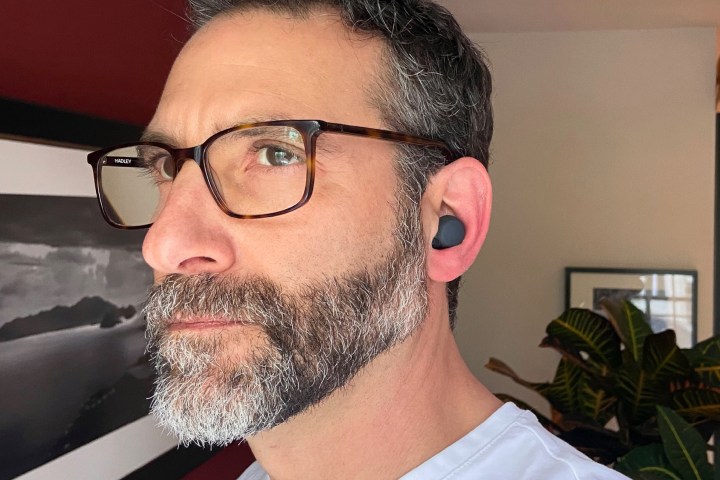
The LinkBuds S are both small and very light. And compared to the WF-1000XM4 they’re downright puny. That sounds like an obvious recipe for great comfort, and it is. These are easily the most comfortable Sony buds I’ve worn so far. But that feeling of comfort didn’t survive the fit test that Sony includes in its Headphones mobile app.
After trying a variety of ear tip sizes, something the test encourages and makes very easy, I found the only way I could get the test to give me a passing grade on the left side was to wedge the LinkBuds S further into my ears than was comfortable. There’s a reason Sony offers the fit test: Getting a good seal is absolutely essential for maximum sound quality, noise canceling, and transparency features. But not at the expense of an uncomfortable fit. Bottom line, try all of the ear tips, but don’t go crazy if the test doesn’t pass you — as I’ll discuss later, it didn’t seem to compromise my experience at all.
Sony’s touch controls are very good and provide a helpful tone to let you know when you’ve tapped successfully. Doing so is relatively easy, but the upper half of the outer surface was much more sensitive to taps. Touching the bottom portion seldom worked.
The LinkBuds S give you single-, double-, and triple-tap gestures to work with as well as tap-and-holds. Between the two earbuds, that’s a total of eight possible actions, but Sony continues to use a control customization scheme that prevents you from selecting the specific functions you want. Instead, you must choose from one of four control “groups” and you can assign only one group to each earbud. Your choices are: Ambient sound control/quick access, playback control, volume control, or no action.
Connecting the LinkBuds S is fast and easy, and the link proved very reliable.
This creates an unfortunate situation where you must choose what matters most. Want to control volume and playback? Sure thing, but you won’t be able to control ANC, transparency, or get access to features like Spotify Tap. Want playback and ANC? No problem, but you’ll have to control the volume with your phone.

You can remove an earbud at any time and the wear sensors will automatically pause your tunes. It works very quickly, but you can disable it in the app if you like.
Thanks to support for Google Fast Pair and Microsoft Swift Pair, connecting the LinkBuds S is fast and easy, and the link proved very reliable the entire time I was testing them, even with the LDAC codec enabled — something that can affect connection stability. Getting them set up on iOS, while not quite as convenient, was also effortless.
However, it’s worth noting that, like Sony’s other wireless earbuds, the LinkBuds S do not support Bluetooth Multipoint for simultaneous device connections, even when LDAC isn’t in use. Given Sony’s philosophy for the LinkBuds of “always on/never off” this is an especially odd omission. Another limitation: You can use the right earbud on its own for music or calls, but if you choose to use advanced features like Spotify Tap, the left earbud won’t be able to operate independently.
Sound quality

Sony has found a very pleasing sound formula for the LinkBuds S. Without going anywhere near the included EQ adjustments in the Headphones app, the factory tuning is very close to neutral, with a nice balance of frequencies, and a midrange that is more detailed than I was expecting. And it has managed to do this using dynamic drivers that are just 5mm — half the size of what you’ll find in similar products.
I noticed the same thing when reviewing Sony’s newest top-of-the-line noise-canceling headphones, the WH-1000XM5: The company has dialed back the boost, especially in the low-end bass. Which is not to say these buds can’t thump — they can. But you may need to reach into the settings and max out the Clear Bass option in the EQ control panel if that’s what you’re looking for. Clarity across the spectrum is good, but the highs don’t ring quite as crystal clear as you’ll find on the Jabra Elite 7 Pro, or the 1More Evo. Here, too, judicious tweaking of the EQ can help the vocals soar just a bit more.
The soundstage, while not especially wide or deep, is precise, and there’s good separation of instruments.
It’s the best ANC you’ll find for this price in a set of wireless earbuds.
My only disappointment is with the LDAC codec — that special ingredient that lets Sony claim wireless hi-res audio compatibility for the LinkBuds S. In doing A/B comparisons between the same 24-bit lossless versions of tracks on Amazon Music on both an iPhone 11 using AAC, with DSEE Extreme turned on, and on a Xiaomi 12 Pro using LDAC, the difference was so minute, I’m not sure I can even claim to have heard it.
Perhaps that’s simply a testament as to how good Sony’s DSEE upscaling technology works, but I feel like other LDAC-enabled earbuds, like the Technics EAH-AZ60 and 1More Evo offered a greater improvement when using this codec.
Noise cancellation and transparency

Active noise cancellation (ANC) is one of Sony’s core strengths in the personal audio world, and the LinkBuds S do a very good job of showcasing that competence. Sitting in my home office, which is unfortunately located right beside a bathroom, I’m perpetually jumping up from my chair to shut off the noisy extractor fan. With the LinkBuds S, there’s no need. In fact, I can’t even tell that the fan is running.
That same performance will keep noisy traffic sounds at bay, and you’ll even be able to walk past heavy machinery without reaching for your volume settings. Wind noise didn’t even register as I was out one blustery morning. And under my motorcycle helmet, it reduced the very loud wind and engine noise down to a low rumble. It’s the best ANC you’ll find for this price in a set of wireless earbuds.
Transparency also is excellent. Not quite the “invisible” level of transparency you’ll get from the AirPods Pro, but I think it’s just as good as the WF-1000XM4. But what makes transparency mode on the LinkBuds S is the incredible level of control you get, thanks to additional settings in the Headphones app.
Speak-to-chat, which Sony has cloned from the WF-1000XM4, uses sensors to detect when you’re speaking and automatically engages transparency mode while simultaneously muting your audio. It’s a great convenience — especially when your hands are full — and it works really well, though on a few occasions it mistook gear changes on my bike for speech. Sony says some vibrations will cause this kind of false positive.
You can also use the quick-attention function by tapping and holding whichever earbud you’ve assigned to ANC functions. Sony adapted this from its wireless headphones, but it doesn’t react quite as quickly on the LinkBuds S.
Call quality

The LinkBuds S perform well under relatively quiet conditions, but like most wireless earbuds, they can become a bit uneven when background noises increase. Not that your callers will hear much of that disturbance. To them, the only sign that you’re in a loud location will be the wobble and compression that happens to your voice.
Curiously, the original LinkBuds have slightly clearer call quality, possibly because their processors and mics don’t have to do the double-duty of providing ANC and ENC (the noise cancellation performed when on a call) at the same time.
Battery life
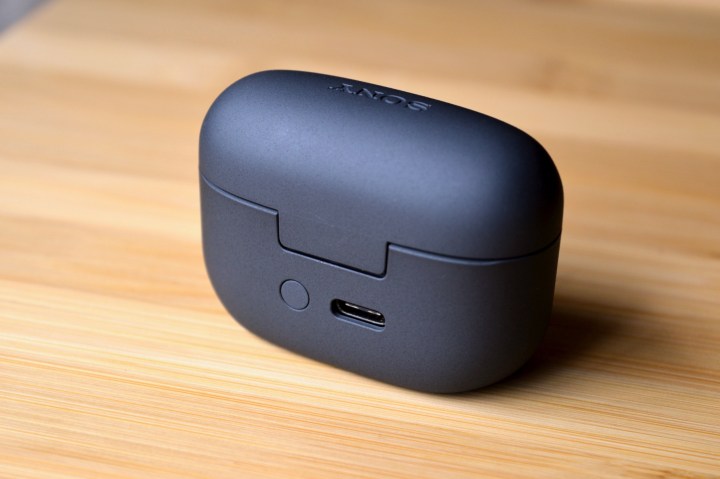
Strangely, for a set of earbuds that purport to be an all-day, always-on, never-off companion, the LinkBuds S only have average battery life, if that. Sony claims you’ll get six hours per charge with ANC turned on, and nine hours when both ANC and transparency are off. With ANC on, you’ll get 20 hours total when you include the charging case. That’s certainly enough for an entire day (unless you only sleep four hours per night), but not much more.
But be warned: Those numbers can drop precipitously when you use some of the extra features. For instance, I found that I only got about 3.5 hours of use with ANC, speak-to-chat, and Alexa with voice activation enabled. But that was with an iPhone using AAC and DSEE Extreme. If I had been using LDAC on top of those other features, I expect it would have been closer to 2.5 hours or less.
A five-minute quick charge will give you an extra hour of play time if you need it.
Extras
Sony has packed the LinkBuds S with a huge set of features, some of which I didn’t have time to test, and others that simply weren’t ready to use because they were still under development. Here’s what you can expect:
- Spotify Tap: If you have the Spotify app installed and open on your phone you can choose to use a double- or triple-tap gesture to resume a previously started playlist, or repeat the gesture to get a new song recommendation.
- Endel Quick Access: Like Spotify Tap, if you have the Endel meditation app, you can start a personalized soundscape for relaxation, sleep, or increased focus.
- Wake word access to assistants: You can trigger Alexa or Google Assistant (Android) just by saying “Hey Google,” or “Alexa,” — on iOS, you can only choose Alexa.
- Spatial audio for AR: Sony intends for people to use the LinkBuds S with AR games like Niantic’s Ingress. When playing, you’ll be able to experience sound cues that are tied to physical locations, so even as you move your head, those sounds will always appear to be coming from the same place.
- Auto Play: You can install yet another app called Auto Play that will let you assign your favorite playlists from Spotify and other streaming music services to specific actions, like ending a call, or putting the earbuds in your ears. The app will also let audio notifications be read aloud over your music, without pausing.
- Bluetooth LE Audio: Sony says that the LinkBuds S will be compatible with the new Bluetooth LE Audio standard, which, among other things, promises to reduce latency dramatically, which gamers — perhaps those playing Ingress — will appreciate.
Our take
The LinkBuds S are small, light, and get a lot of things right, like sound quality and ANC. But their greatest strength is an ability to intelligently let you go about your day without reaching for the controls, through voice-activated assistants and transparency mode. But with hi-res audio that doesn’t sound noticeably different from regular wireless connections, battery life that’s on the short side, and no wireless charging or Bluetooth Multipoint, it’s not clear whether their strengths are enough to warrant buying them over the many other great earbuds at or near this price.
Are there better alternatives?
Most people who are looking for noise-canceling wireless earbuds will be happier overall with the $200 Jabra Elite 7 Pro. Their sound quality is nearly identical, despite lacking LDAC, and they’re champs for voice calls. Sony’s ANC is better, but the Elite 7 Pro are no slouches in this department either. The Jabras have better battery life, better protection from dust and water, and their charging case supports wireless charging. They have Bluetooth Multipoint, too, which is a huge convenience when using two devices like a phone and a computer.
If sound quality and noise cancellation are your two main priorities, it’s worth spending another $30 on the excellent Technics EAH-AZ60, which excel in both categories.
How long will they last?
Sony’s products are very well built, and that includes the LinkBuds S. With IPX4 protection, they should survive most workouts, and Sony backs them with a standard one-year warranty.
Should you buy them?
Yes, but only if you think the LinkBuds S’ specific features answer a need(s) you have, that other products simply can’t match. But otherwise, I think there are better choices.
Editors' Recommendations
- Nothing’s new earbuds upstage Apple, Google, and Amazon by embedding ChatGPT
- 1More’s PistonBuds Pro Q30 look like great budget buds at $50
- Best noise-canceling earbuds for 2023: from Sony, Soundcore, Jabra, and more
- Dali says its latest wireless headphones achieve electrostatic levels of clarity
- Olivia Rodrigo’s latest collaboration is a set of limited-edition Sony LinkBuds S






